Asking about people’s activities, habits and rituals is one way to explore how abstract concepts such as spirituality and religion show up in everyday life.

In this survey, we asked respondents to tell us whether they pursue a variety of activities – such as meditating and spending time in nature – for reasons that might be considered spiritual, such as to make a connection with something bigger than themselves or to connect with their “true self.”
We also asked whether they possess a range of things – such as a cross, a home altar or crystals – for spiritual purposes. And we asked whether they are involved in religious and spiritual communities and, if so, how important those involvements are to them.
We found that:
- 14% of Americans say they are involved in a spiritual community, including 8% who say they’re involved in a spiritual community and that it’s extremely or very important to them.
- 36% have a cross for spiritual reasons. Fewer say they possess jewelry (19%), crystals (12%) or a tattoo or piercing (9%) for spiritual purposes. Religiously unaffiliated Americans are more likely than religiously affiliated adults to own crystals for spiritual purposes.
- 64% of U.S. adults say they spend time each month looking inward or centering themselves. Most of them – 44% of all U.S. adults – say they do this primarily to feel connected with their “true self,” with something bigger than themselves or with other people.
This chapter explores these questions in more detail. For the related topic of spiritual experiences, jump to Chapter 4.
Spiritual and religious communities
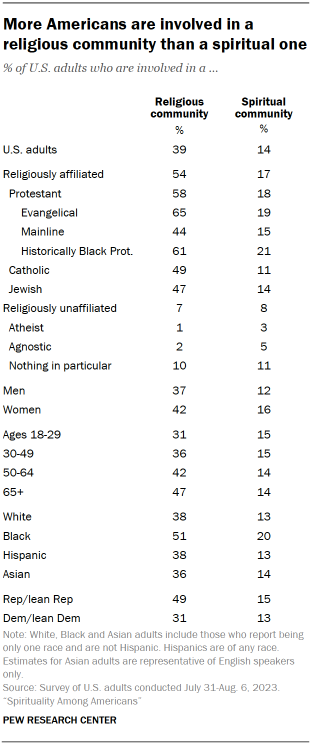
About four-in-ten U.S. adults say they are involved in a religious community, such as a church or religious congregation. This includes 54% of religiously affiliated Americans.
By comparison, relatively few Americans say they belong to a spiritual community, such as a group that helps them find a connection with something bigger than themselves, with nature or with other people (14%).
Most of these people – 10% of all U.S. adults – say they are involved in both a religious community and a spiritual community. Indeed, it is possible that some respondents are describing the same community as both religious and spiritual.
Just 4% of U.S. adults say they are involved in a spiritual community and not also in a religious community.
U.S. adults who are affiliated with a religion are much more likely than religiously unaffiliated Americans (sometimes called “nones”) to be involved in a religious community (54% vs. 7%). The same is true of spiritual communities, though the gap is much narrower: 17% of religiously affiliated adults say they are part of a spiritual community, compared with 8% of “nones.”

And among U.S. adults who are involved in a spiritual community, those who have a religion are more likely than those who are religiously unaffiliated to say that being part of such a community is either extremely or very important to them.
Among religiously affiliated adults, 11% are involved with a spiritual community and say this is extremely or very important to them. The comparable figure among religious “nones” is 3%.
Having things for spiritual purposes
Many Americans say they have one of the following items for spiritual purposes: a cross (36%), jewelry (19%), a shrine, altar or icon in their home (15%), crystals (12%) or a tattoo or piercing (9%).
Catholics are especially likely to own a cross: 72% say they have a cross for spiritual purposes, compared with 42% of Protestants.
Meanwhile, 18% of U.S. adults who describe their religious identity as “nothing in particular” say they have a cross for spiritual purposes, as do very small shares of agnostics (6%), Jews (6%) and atheists (1%).6
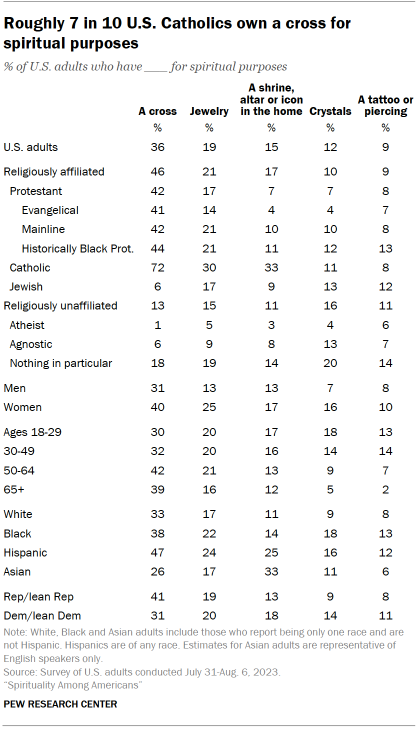
Catholics are also more likely than others to have a shrine, altar or icon in their homes (33%), or to have jewelry for spiritual purposes (30%).
There are also some differences by race and ethnicity. About half of Hispanic Americans (47%) say they have a cross for spiritual purposes, compared with fewer Black (38%), White (33%) or Asian Americans (26%).
Asian Americans (33%) are more likely than Hispanic (25%), Black (14%) or White (11%) Americans to have a shrine, altar or icon for spiritual purposes. Similarly, a recent Center survey designed specifically to collect data on Asian Americans, conducted in 2022-2023 in five Asian languages as well as English, found that 36% of Asian Americans have a shrine, altar or religious symbol that they use for worship in their home. This includes 63% of Asian American Buddhists and 79% of Asian American Hindus.
Another recent Center survey, conducted in July 2023, found that 32% of U.S. adults say they have a tattoo, including 22% who have more than one. The July survey did not ask whether the tattoos have a spiritual purpose. But it found that among Americans who have tattoos, 69% said one reason they have a tattoo is to “remember or honor someone or something,” while 47% said they have a tattoo to “make a statement about what I believe.” The July survey also found that 41% of religiously unaffiliated adults have at least one tattoo, compared with 29% of those affiliated with a religion.
Activities that create connection
In this survey, we offered respondents a list of five activities and asked them how often they engage in each one. The activities were: spending time looking inward or centering yourself, spending time in nature, exercising, meditating, and practicing yoga.
We then asked people who engage in an activity at least a few times per month to choose the most important reason they do it. The options were: “To feel connected with something bigger than myself,” “To get health benefits, including relaxation,” “To feel connected with other people,” “To feel connected with my true self,” “To have fun and enjoy the experience” and “For a different reason” (which they were then asked to specify).
Looking inward
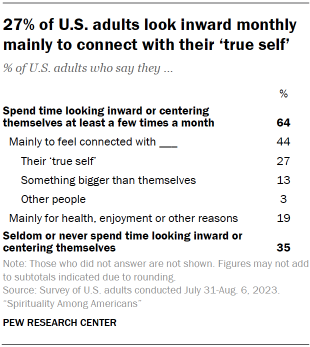
More than four-in-ten U.S. adults say they spend time looking inward or centering themselves at least a few times a month mainly to feel some sort of connection – most commonly, with their “true self” (27%).
An additional 13% say the most important reason they look inward or center themselves is to connect with something bigger than themselves.
About one-in-five adults say they look inward regularly for health, enjoyment or other reasons.
Time in nature
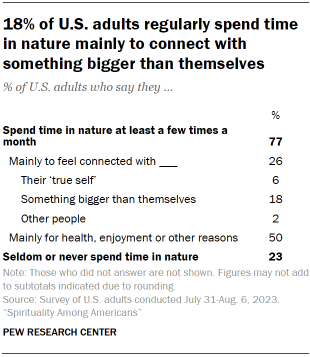
Roughly one-in-five American adults (18%) say they spend time in nature a few times a month or more mainly to feel connected with something bigger than themselves.
Smaller shares say they do this to feel connected with their “true self” (6%) or to other people (2%).
Half of U.S. adults say they spend time in nature a few times a month or more mainly for health, enjoyment or other reasons.
Exercise
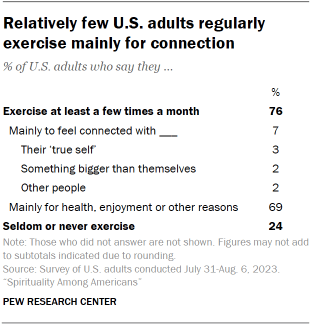
A large majority of U.S. adults who engage in exercise at least monthly cite health, enjoyment or other reasons as their main motivation (69%). Just 7% of adults say they engage in exercise monthly to feel some sort of connection.
Meditation
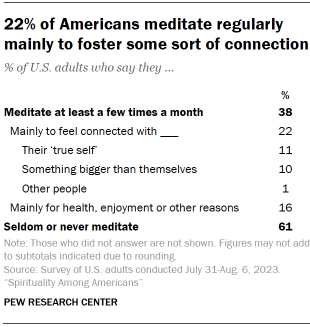
About a fifth of U.S. adults (22%) say they meditate at least a few times a month with the primary goal of feeling some sort of connection.
Similar shares say they seek connection with their “true self” (11%) or with something bigger than themselves (10%). An additional 16% of American adults say they meditate regularly for health, enjoyment or other reasons.
Yoga
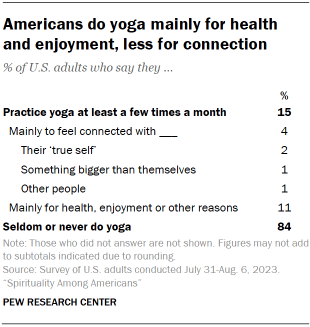
An overwhelming majority of U.S. adults (84%) say they seldom or never practice yoga. About one-in-ten say they do yoga at least a few times a month mainly for health, enjoyment or other reasons. Another 4% of U.S. adults say they practice yoga at least monthly primarily to feel connected with their “true self,” with something bigger than themselves or with other people.


